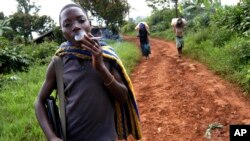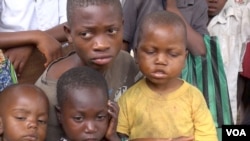Thousands of children in the troubled Kasai region of the Democratic Republic of Congo have been used as combatants over the last two years amid conflict between local militia and government forces. In the last few months, some 1,000 of them have trickled into rehabilitation centers run by aid agencies.
Their troubles are far from over, aid workers say. The horrors they endured come back to them in whispers, fragments — and nightmares.
“I joined the militia in 2016,” says Muyaya, a lean, shy boy of 16 who says he spent a year fighting with the Kamwina Nsapu armed group. He did not give details about what violence he may have seen or committed.
His story unfolded haltingly over the course of an hour, as dozens of his neighbors thronged around, eager to hear details that he is clearly uncomfortable recalling. VOA interviewed him in the presence of counselors from a rehabilitation center run by a Christian charity and the United Nations Children’s Fund (UNICEF) with the permission of his legal guardian, his uncle.
UNICEF estimates that overall, the violence has impacted as many as 60 percent of local children — and that as many as 10,000 children were involved in the militia.
Armed with ‘magic’ for battle
Rehabilitation is a slow and complex task, aid workers say.
“When they’ve lived these traumas, it’s even difficult to bring together, to put together a memory,” said Oscar Butragueno, UNICEF’s emergency coordinator in Kasai. ”It’s made of bits and pieces of things that happened. Sometimes they were used under the effects of drugs. During the conflict, children would be given a prominent rule when they were fighting the military. The boys were sent in advance, because under the magical perception that bullets wouldn’t kill them, which obviously is not the case. And then the girls would be sent second, in the second line, because they thought that their skirts would actually absorb the bullets as well.”
Muyaya said this is exactly what happened to him — militants handed him a stick that they said would magically protect him and sent him and other boys headfirst into pitched battles. He says he wasn’t afraid — rather, he was “hypnotized” and unable to feel fear.
Muyaya said he had agreed to tell his story to journalists to help him move on. He says he is hopeful about his future and wants to become a construction worker. But he has had trouble returning to his parents — instead, he now lives with a baby-faced uncle, who at 24, says that he is expecting his first child soon. In this impoverished region, that means Muyaya’s childhood has come to a sudden end.
In the presence of counselors, VOA spoke to five children, most of them in their teens, who are thought to have been involved in militia activities. Not a single one could describe the cause their lives were risked for.
The conflict began in 2016 after local traditional leaders clashed with security forces. U.N. rights investigators accuse both sides of committing heinous crimes. More than 1.4 million people fled that violence.
Earlier this week, the United Nations Security Council discussed the situation across Congo, where top humanitarian chief Mark Lowcock said 13 million people now need aid.
Slow path to rehabilitation
UNICEF is calling for $11.5 million this year to help reintegrate children after they’ve left armed groups. The process is slow and complex, workers at the rehabilitation center say.
“When I ran away from the militia, I forgot everything,” said 14-year-old Nona Marie, a resident at a UNICEF-sponsored rehabilitation center for children involved in the conflict.
Counselors also pointed to a little girl with a serious face and a dress two sizes too big. She says her name is Anita, and doesn’t know her last name, the name of her village or where her parents might be. She says they fled in separate directions when the fighting started. She says she’s 11, but adults at the center say she can’t be older than nine.
Workers at the center say it has taken them weeks to piece together a narrative: They believe Anita’s father was a policeman who joined the militia. They don’t know if he primed her for militia service, or what her role was.
Only one detail, they say, shines reliably — and repeatedly — through Anita’s muddled memory.
“My mother’s name is Mbombo,” she said, a smile crossing her face. “She’s beautiful. Her hair is dark and curly.”









